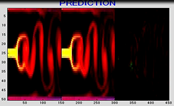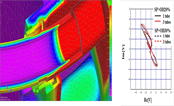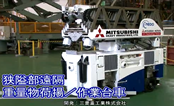Nuclear Plant Service Engineering Co., Ltd. (NUSEC)
To reduce radiation exposure in the periodic inspection at the nuclear power plant, the radiation shields are installed for working in the relatively high radiation area. Most of the radiation shields are composed of heavy metal sheets and plates, and it takes a lot of time to install or remove them because of carrying the heavy load.
We have developed the tungsten-ball-filling-type radiation shielding system, and since 2009, applied it to the pressurizer surge nozzle repair at the nuclear power stations.
This system enables it to cut installation/removal time of the shield, which is good for reducing radiation exposure. For example, in the area where the shield equivalent to a 3cm-thick lead plate is required, the system can reduce the workload by a tenth. This lead-free system also leads to reduction in the hazardous waste because of using tungsten balls. Furthermore, as one of the features of this system, the jacket structure is changeable, which enables the application to the more various shield area than ever.
In the tungsten ball shielding system, the hollow and lightweight shield shell (the jacket) is installed at the object to be shielded, and then the tungsten balls are filled/ collected remotely. As shown in Fig.1, this system consists of a tungsten ball loader, a hollow and lightweight shield jacket, a tank for storage of the tungsten balls and the fluid which carries the tungsten balls to the shield, and a pump.
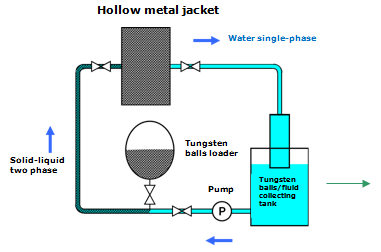
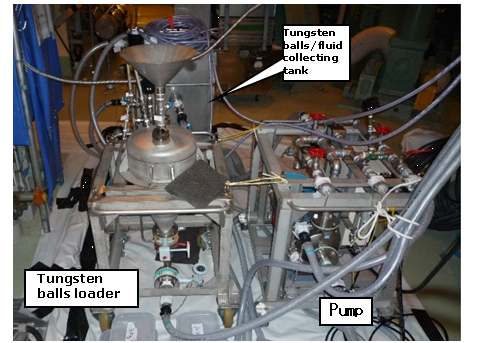
Fig. 1 Tungsten Ball Shielding System
When installing the shield, the carrier fluid, water, is flown by the pump to the tungsten ball loader, it mixes the tungsten balls with water. Next, the tungsten balls move to the empty metal jacket and the tungsten balls move to the empty metal jacket and are filled in it. Finally, the carrier fluid is drained from the jacket and the shield is ready to use. When removing the shield, the water is pumped again and carries the tungsten balls back to the tank.
Phase 2 : applied to the actual plants
- The system has applied in the pressurizer surge nozzle repair in Japan since 2009.
- (1) Components: General radiation-emitting components or pipes
- (2) Location: The area where the worker may be exposed to radiation during maintenance or checkup
- (3) Material: Regardless of material
- (4) Condition: In air
- (1) By adopting the hollow jacket structure of the shield, the shield became lightweight and easily removable from/attachable to the object. The number of the parts can be reduced.
- (2) By filling the tungsten balls to the jacket remotely, the amount of handling of the heavy load decreases dramatically.
- (3) The tungsten balls can be filled/collected by remote control from 20 m away (including difference in height).
- (4) Tungsten can be treated as the general waste, which means no hazardous waste from the system.
Supplementary explanation
(1) Comparison to the shield of the metal plates
In the shielding method with the metal plates, the shield is composed of the heavy metal sheets and plates, and when applied at the pressurized bottom nozzle area (Fig. 2), several plates shall be needed because of the weight of a plate. At this time, the required time for installation/removal of the shield is ca. 16 hours by two workers.

Fig. 2 Image of attaching the metal plates
On the other hand, in the shielding system with the tungsten balls shown in Fig. 3, first the rack with eight legs is installed as same as the shielding system with the metal plates. However, the next step is installation of the eight metal jackets, which have the holes to avoid the heater installed at the bottom of the pressurizer and are easy to attach. The required time is ca. three hours by two workers.
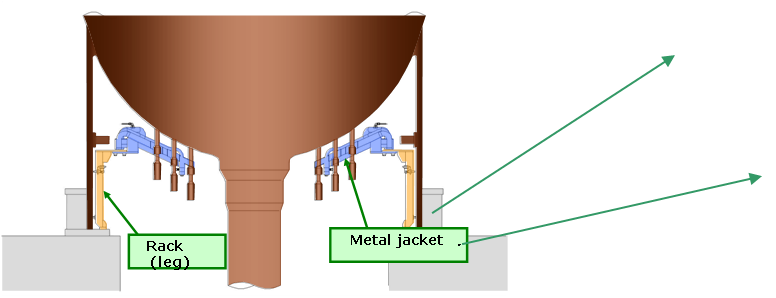

The former required time for installation/removal of both methods mentioned above is 32 man-powers (16 hours x 2 workers) and the latter is 6 hours (3 hours x 2 workers), which means the system with tungsten balls can reduce the required time by about a fifth. Also, the former exposure dose in whole construction is 56 man・mSv and the latter is 8 man・mSv, which means the system with tungsten balls can reduce the exposure by about a seventh.
(2) Appearance of the tungsten balls
To confirm the filling/collecting performance of the tungsten balls, we made the mock-up metal jacket and conducted the visualization test. As the result, the layer appearance of the tungsten balls effective for the reduction of radiation exposure and the recovery performance effective at the removal of the jacket were confirmed (Fig. 4).
Fig. 4 Appearance of filling/collecting the tungsten balls
Pressurizer surge nozzles of 8 Nuclear Power Stations from 2009 to 2011
- [1] Takeshi Ueda et al.: 2009 ISOE Asian ALARA Symposium (Session-4)
- [2]Yukihide Shimazu et al.: JSM 7th Annual Conference at Omaezaki, Shizuoka(B-5-7)
Japan Society of Maintenology (ejam@jsm.or.jp)



